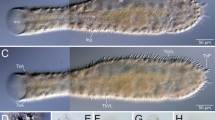Summary
Pre-cloacal glands occur in some species of amphisbaenians. Although these glands are important in systematics, their biology and chemistry are little known. The pre-cloacal glands of Amphisbaena alba are of the holocrine type. They are made up of a glandular body and a duct. The glandular body is conical to elongate and is formed of clongatc lobules separated one from another by collagen septa. Each lobule is composed, at its periphery, of germinative cells, and within of polyhedral secretory cells, of different degrees of differentiation. The germinative cells, set on a basal lamina, are basophilic and their cytoplasm is fairly electron dense. The polyhedral cells display bulky cytoplasm, filled with spherical granules, wrapped in membranes and differing in their electron densities. Towards the lumen of the gland, these granules are increasingly eosinophilic and have an affinity for orange G. The secretion is discharged into the duct leading to the pore, which is situated in the central region of the scale. This secretion shows positive histochemical results for mucopolysaccharides and proteins. The similarity between the epidermal glands of lizards and those of A. alba raises the suggestion that the glands have equivalent functions, possibly in the course of intra- or interspecific communication.
Similar content being viewed by others
References
Abrahám A (1930) Über die Schenkeldrüsen der Archaeo- und Neolacerten. Stud Zool Budapest 1:204–225
Alberts AC (1990) Chemical properties of femoral gland secretions in the desert iguana Dipsosaurus dorsalis. J Chem Ecol 16:13–25
Alberts AC, Pratt NC, Phillips JA (1992) Seasonal productivity of lizard femoral glands: relationship to social dominance and androgen levels. Physiol Behav 51:729–733
Bancroft JD, Stevens D (1982) Theory and practice of histological techniques, 2nd edn. Churchill Livingstone, London
Chauhan NB (1986) Histological and structural observations on pre-anal glands of the gekkonid lizard, Hemidactylus flaviridis. J Anat 144:93–98
Chiu KW, Maderson PFA (1975) The microscopic anatomy of epidermal glands in two species of gekkonine lizards, with some observations on testicular activity. J Morphol 147:23–40
Chiu KW, Maderson PFA, Alexander SA, Wong WL (1975) Sex steroids and epidermal glands in two species of gekkonine lizards. J Morphol 147:9–22
Cole CJ (1966a) Femoral glands of the lizard Crotaphytus collaris. J Morphol 118:119–136
Cole CJ (1966b) Femoral glands in lizards: a review. Herpetologica 22(3):119–206
Fergusson B, Bradshaw SD, Cannon JR (1985) Hormonal control of femoral gland secretion in the lizard, Amphibolurus ornatus. Gen Comp Endocrinol 57:371–376
Gabe M, Saint-Girons H (1965) Contribution à la morphologie comparée du cloaque et des glandes épidermoides de la région cloacale chez le lépidosauriens. Mém Mus Natl Hist Nat Paris Ser A Zool 33(4):149–292
Gans C (1969) Amphisbaenians — reptiles specialized for a burrowing existence. Endeavour 28:146–151
Gasc JP, Lageron A, Schlumberger J (1970) Morphologie, histologie et histochimie des glandes fémorales chez un individu mâle de Ctenosaura acanthura (Shaw) (Reptilia, Sauria, Iguanidae), suivi des réflexions sur le rôle des glandes fémorales chez les lézardes. Gegenbaurs Morphol jb 144:572–590
Jullien R, Renous-Lécuru (1973) Etude de la repartition des pores fémoraux, anaux, pré-anaux et ventraux chez les Lacertiliens (Reptilia). Bull Mus Natl Hist Nat 104:1–32
Lison L (1960) Histochimie et cytochimie animales, 3rd edn. Gauthiers Villar, Paris
Maderson PFA (1972) The structure and evolution of holocrine epidermal glands in Sphaerodactyline and Eublepharine gekkonid lizards. Copeia 1972(3):559–571
Maderson PFA (1985) Some developmental problems of the reptilian integument. In: Gans C (ed) Biology of the Reptilia, vol 14. John Wiley and Sons, New York, pp 525–598
Quay WB (1972) Integument and environment: glandular composition, function and evolution. Am Zool 12:95–108
Steedmann HF (1950) Alcian blue 8GS: a new stain for mucin. Q J Microsc Sci 91:477–479
Uva B (1967) I pori femorali in Lacerta Podargis sicula. Boll Mus Ist Biol Univ Genova 35:169–183
Whiting AM (1967) Amphisbaenian cloacal glands. Am Zool 7:776 (abstract)
Author information
Authors and Affiliations
Rights and permissions
About this article
Cite this article
Antoniazzi, M.M., Jared, C., Pellegrini, C.M.R. et al. Epidermal glands in Squamata: morphology and histochemistry of the pre-cloacal glands in Amphisbaena alba (Amphisbaenia). Zoomorphology 113, 199–203 (1993). https://doi.org/10.1007/BF00394860
Received:
Issue Date:
DOI: https://doi.org/10.1007/BF00394860




